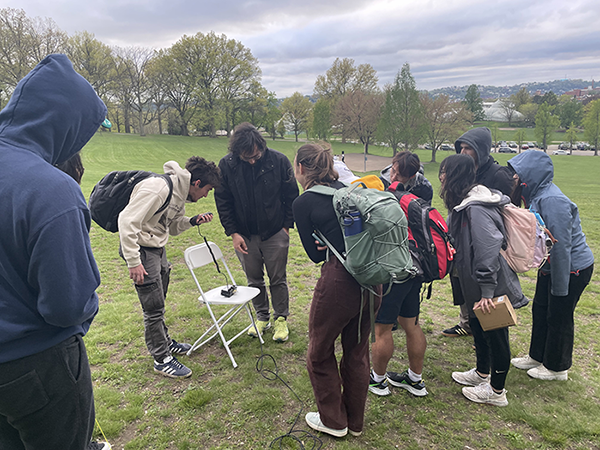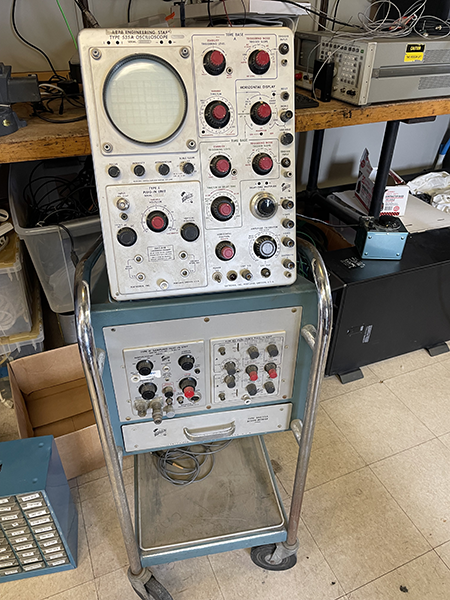Amateur radio for aspiring professionals
Introductory course gives engineering students hands-on experience with radio technology and opportunities to explore its use as a hobby, public service, and means of technical experimentation.
They were born into the age of satellite internet technology, have likely been using their own mobile phones since they were preteens, and may someday use their Carnegie Mellon degrees to contribute to technological advances that will further speed the rates at which we communicate. But the 20 students enrolled in the Introduction to Amateur Radio course were still thrilled when they made their first contact with other amateur radio operators during the field day class held at the end of the spring semester.
“Hearing a response on the radio today was pretty exciting,” said Caroline Kasuba, who enrolled in the class at the suggestion of a classmate whose German grandfather was a ham operator.
Kasuba is a first-year master’s student in electrical and computer engineering. She is in the college’s Integrated Master’s and Bachelor’s program, which allows students who excel academically to seamlessly earn both their bachelor’s and master’s degree at Carnegie Mellon.
So much of what I do in other classes is coding on a computer, which made the hands-on aspect of this class very appealing.
Caroline Kasuba, student, Integrated Master’s and Bachelor program, Electrical and Computer Engineering
“I’ve really enjoyed the class. So much of what I do in other classes is coding on a computer, which made the hands-on aspect of this class very appealing.”
Her classmate Markos Koukoularis, who is a first-year mechanical engineering student, agreed.
“I like making things, and we got to make a radio,” said Koukoularis, who liked that the class helped him better understand radio technology, circuitry, and signal processing that he is learning in other classes.
The course introduces students to the history, art, and science of radio with emphasis on hands-on demonstrations and in-class projects, including soldering a low-power FM transmitter and building a directional antenna. Topics covered include radio signal fundamentals, basic electronics, antennas, radio wave propagation, radio equipment, norms and culture of amateur radio communication, operating regulations, and safety.

Markos Koukoularis repeats, “Whiskey Three Victor Charley,” the phonetics for W3VC—the Carnegie Tech Radio club’s callsign they used to contact other ham radio operators.
Tom Zajdel (radio callsign: AI6CU), an assistant teaching professor of electrical and computer engineering, teaches the course, which is open to students throughout the university but tends to attract mostly engineering students who use the course to fill elective requirements.
Zajdel says his dad got him and his brother into amateur radio when they were young. Despite that early exposure to circuitry and signals, he didn’t take engineering seriously until the very end of high school and didn’t return to amateur radio again until he was a Ph.D. student at UC Berkeley. He was lured back to amateur radio when his professor and mentor, Miki Lustig, (callsign KK6MRI), asked him to teach an amateur radio seminar while he was on sabbatical. He’s taught the Carnegie Mellon course each spring since 2022.
Students in the class are expected to pass the Technician Class licensing exam, which gives them access to all amateur radio frequencies above 30 megahertz, allowing them to communicate locally and with others in North America. Once they pass the exam, they are licensed to use the hand-held radio each student receives. Students who had already earned the Technician Class license are expected to earn the General Class license, which expands their access to world-wide communication with sub-30-megahertz frequencies. These frequencies use the earth’s ionosphere as a radio reflector, redirecting the signals to distant stations.
They want to know more about the cultural aspects of ham radio, and they like learning about what the ham operators talk about when they connect.
Tom Zajdel, Assistant Teaching Professor, Electrical and Computer Engineering
“They want to know more about the cultural aspects of ham radio, and they like learning about what the ham operators talk about when they connect. It shows their interest in the people who use the technology, which is neat considering the high-tech careers students are interested in,” said Zajdel.
Zajdel offers the students extra credit for participating in extracurricular activities. He encourages them to join an amateur radio net gathering. Also known as ham nets, the gatherings typically convene on a regular schedule, at a specific frequency, and are organized for a particular purpose, such as relaying messages or discussing a common topic of interest.
The students can also volunteer with the Carnegie Tech Radio Club (callsign W3VC). The 110-year-old campus student group, whose members share an interest in amateur radio, explore and upkeep radio equipment housed in their meeting space in the tower of Hamerschlag Hall and participate in projects and activities related to digital radio systems, robotics, satellite communication, and morse code.

Students in the Introduction to Amateur Radio class built dipole antennas to use with software-defined receivers to visualize the radio spectrum.
The club members are also responsible for racecourse communications during the Buggy races held during the university’s annual Spring Carnival.
Anish Singhani, president of the club, explains that they work with the emergency management service workers to track the races and respond to any incidents.
“Our radios are better than cell phones because we have lowest latency,” explained Singhani.
Ham radios operate on frequencies exclusively allocated for amateur radio use. When you transmit a signal via ham radio, it travels directly from the transmitter to the receiver, without the need for intermediate relay stations like cell towers. This direct communication path reduces latency and enables real-time communication, allowing individuals to exchange information with minimal delay.

An antique Textronics 535A Oscilloscope featuring a cathode ray tube display, manufactured between 1954 and 1973 is one of the many pieces of radio equipment that members of the Carnegie Tech Radio Club maintain in their Hamerschlag Hall meeting space.
That’s one of the reasons that, despite the advent of cellular, internet, and satellite communication, amateur radios are still used during emergencies. Ham radio operators often play a critical role in providing communication when other networks fail or are not available.
But for students who learn amateur radio and earn licenses, whether through the club or the class, many can’t resist the lure of randomly connecting with other operators in far off places who share their interest in the radio technology that is the basis of the advanced technologies many of these students will work with as Carnegie Mellon graduates.
Pictured, top: Students in the Introduction to Amateur Radio course gather on Flagstaff Hill to try out several antennas and connect with other ham radio operators.
